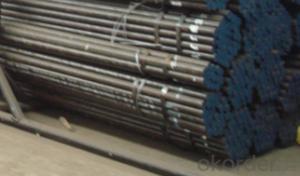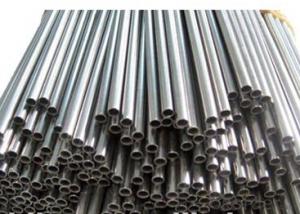Cold Drawn Carbon Steel Seamless Pipe 12Cr1MoV CNBM
- Loading Port:
- Qingdao
- Payment Terms:
- TT OR LC
- Min Order Qty:
- 10 pc
- Supply Capability:
- 30 pc/month
OKorder Service Pledge
OKorder Financial Service
You Might Also Like
Quick Details
| Thickness: | 1.2 - 20 mm | Section Shape: | Round | Outer Diameter: | 12.7 - 168 mm |
| Secondary Or Not: | Non-secondary | Application: | Boiler Pipe | ||
| Technique: | Cold Drawn | Certification: | PED | Surface Treatment: | oil coating |
| Special Pipe: | Thick Wall Pipe | Alloy Or Not: | Is Alloy | ASTM A213: | T2,T5,T9,T11,T12,T22,T23,T91,T91 |
| ASTM A335: | P1,P2,P5,P9,P11,P12,P22,P23,P91,P92 | DIN17175: | 15Mo3,10CrMo910,12CrMo195,13CrMo44 | Grade: | 12Cr1MoV,Cr5Mo,Cr9Mo,12Cr1MoVG,Cr5MoG,A335 P11,A335 P5,A335 P9,A335 P1,A213,A192,A210,A335 P12,A335 P23,St35.8,Cr-Mo alloy,A53-A369,ST35-ST52 |
| Standard: | BS 3059-2,DIN EN 10216-1-2004,DIN 17175,ASTM A213-2001,ANSI A210-1996,ASTM A179-1990,BS,DIN,ASTM |
Packaging & Delivery
| Packaging Detail: | Seaworthy export packing |
| Delivery Detail: | 45 Days |
Specifications
Standard:ASTM A179,DIN17175
Material:SA179,ST35.8
Size:12*1.2-168*20
Manufacture:cold drawn
Heat treating: normalized
Product Description
Commodity: cold drawn carbon steel seamless pipe
Standard&material: ASTM A213 T2,T5,T9,T11,T12,T22,T23,T91,T92, ASTM A335 P1,P2,P5,P9,P11,P12,P22,P23,P91,P92, DIN17175 15Mo3,10CrMo910,12CrMo195,13CrMo44, and equivalent standard and material.
Size range: 12mm*1.2mm - 168mm*20mm
Manufacture method: cold rolled, cold drawn
Delivery condition: Normalized, Normalized and Tempered.
Mill test certificate as per EN10204 3.1B is available.
Third party inspection is acceptable.
Tubes will be ECT+UT.
Packaging & Shipping
Packing: tubes will be packed in bundles tied with steel strips.
Oil coating,varnish,or black painting to be confirmed.
End plastic caps to be confirmed.
External packing by knit bags.
Marking: to be confirmed.
- Q:What is the outer diameter of the steel tube?
- The outer diameter refers to the maximum diameter including the thickness of the steel tube, the inner diameter is the length of the hollow part inside, and the outer diameter minus the inside diameter is the thickness of the steel pipe
- Q:How are steel pipes used in the construction of geothermal power plants?
- Steel pipes are used in geothermal power plants for various purposes, including the transport of geothermal fluids from the underground reservoir to the surface, the distribution of these fluids within the plant, and the construction of the plant's infrastructure, such as the well casing and steam piping.
- Q:What are the common standards for steel pipe manufacturing?
- There are several common standards for steel pipe manufacturing that ensure the quality and consistency of the products. One of the most widely recognized standards is the American Society for Testing and Materials (ASTM) standard, which includes various specifications for different types of steel pipes. These specifications cover dimensions, mechanical properties, and testing requirements. Another common standard is the American National Standards Institute (ANSI) standard, which establishes guidelines for the manufacturing process, material requirements, and performance characteristics of steel pipes. ANSI standards are often used in industrial applications and construction projects. In addition to these, there are international standards such as the International Organization for Standardization (ISO) standard, which provides guidelines for the design, production, and testing of steel pipes. The ISO standard ensures that steel pipes meet global quality and safety standards. Furthermore, specific industries may have their own standards for steel pipe manufacturing. For example, the American Petroleum Institute (API) has developed standards specifically for oil and gas industry applications. These standards, such as API 5L, outline requirements for the manufacturing, testing, and inspection of steel pipes used in the transportation of oil and gas. Overall, these common standards for steel pipe manufacturing help to ensure the quality, reliability, and safety of the products. They provide a standardized framework that manufacturers can follow, enabling customers to have confidence in the performance and durability of the steel pipes they purchase.
- Q:Are steel pipes suitable for underground sewage lines?
- Yes, steel pipes are suitable for underground sewage lines. They are strong, durable, and resistant to corrosion, making them an excellent choice for sewage systems.
- Q:Can steel pipes be used for underground fuel pipelines?
- Yes, steel pipes can be used for underground fuel pipelines. Steel pipes are commonly used for underground fuel pipelines due to their strength, durability, and resistance to corrosion, making them suitable for transporting fuel safely and efficiently.
- Q:Can steel pipes be used for culvert applications?
- Yes, steel pipes can be used for culvert applications. Steel pipes are commonly used for culverts due to their durability, strength, and resistance to corrosion. They can withstand heavy loads and are able to handle high traffic volumes and large water flows. Additionally, steel pipes can be easily manufactured in various sizes and shapes to suit specific culvert requirements. Their longevity and low maintenance needs make them a cost-effective choice for culvert applications.
- Q:Is the diameter of the steel tube indicated by the outer diameter by the wall thickness or by the inside diameter by the wall thickness?
- Seamless steel pipe specifications are: outer diameter, wall thickness, material. Three of these reflect its main features.Welding pipe specifications are: nominal diameter (internal diameter), galvanized or non plated
- Q:What are the different types of steel pipe elbows?
- There are several different types of steel pipe elbows that are commonly used in various industries and applications. These types include: 1. 90-degree elbows: These elbows have a sharp 90-degree bend and are commonly used when a change in direction is required to redirect the flow of fluid or gas. They are widely used in plumbing, construction, and industrial piping systems. 2. 45-degree elbows: Similar to 90-degree elbows, 45-degree elbows also provide a change in direction but with a smaller angle. They are often used in situations where a more gradual change in flow direction is required. 3. Long radius elbows: Long radius elbows have a larger radius of curvature compared to standard elbows. This design helps to reduce fluid friction and pressure drop, making them suitable for applications that require smoother flow, such as in high-flow systems or those involving viscous fluids. 4. Short radius elbows: In contrast to long radius elbows, short radius elbows have a smaller radius of curvature. They are generally used in tight spaces where a compact design is required, but they can cause higher pressure drops due to increased fluid friction. 5. Reducing elbows: These elbows are used when there is a need to connect pipes of different diameters. They have one end with a larger diameter and the other end with a smaller diameter, allowing for a smooth transition between two pipes of different sizes. 6. Mitered elbows: Mitered elbows are custom-made elbows that are fabricated by cutting and welding multiple sections of pipe at specific angles. They are often used in situations where standard elbows cannot accommodate the required angle or when a unique design is needed. Overall, the selection of the appropriate type of steel pipe elbow depends on factors such as the application, fluid flow requirements, space constraints, and compatibility with the piping system.
- Q:What are the challenges faced in transporting steel pipes?
- Some of the challenges faced in transporting steel pipes include their large size and weight, which can make them difficult to handle and transport. Additionally, their shape can make it challenging to secure them properly during transportation to prevent damage or accidents. The corrosive nature of steel pipes can also pose a challenge, as special precautions need to be taken to protect them from rust or other forms of damage during transportation. Finally, the cost of transportation can be a challenge, as steel pipes often require specialized equipment and vehicles, which can be expensive to rent or purchase.
- Q:How do you prevent steel pipes from freezing?
- To avoid freezing of steel pipes, there are several actions that can be taken: 1. Insulate the pipes: Utilize foam insulation sleeves or wrap the pipes with insulation tape. This will help maintain the temperature of the pipes and prevent freezing. 2. Seal any gaps or cracks: Examine the area surrounding the pipes and seal any gaps or cracks using caulk or expanding foam. This will prevent cold air from entering and causing freezing. 3. Install heat cables: Wrap heat cables around the steel pipes to provide a constant source of warmth. These cables can be controlled by a thermostat, ensuring that the pipes remain above freezing temperature. 4. Maintain above-freezing temperature: In regions with severe cold weather, it is recommended to keep the indoor temperature above freezing, even if the property is unoccupied. This will help maintain a suitable temperature for the pipes and prevent freezing. 5. Open cabinets and faucets: During extremely cold weather, open cabinet doors in kitchens and bathrooms to allow warm air to circulate around the pipes. Additionally, allowing faucets to drip slightly can keep water flowing and prevent freezing. 6. Drain the pipes: If the property will be vacant during freezing weather, it is advisable to completely drain the pipes. This can be achieved by shutting off the main water supply and opening all faucets until no water remains. This minimizes the risk of freezing and potential damage. Remember, taking preventive measures is vital in safeguarding steel pipes against freezing. By implementing these actions, you can significantly reduce the chances of frozen pipes and costly repairs.
1. Manufacturer Overview |
|
|---|---|
| Location | |
| Year Established | |
| Annual Output Value | |
| Main Markets | |
| Company Certifications | |
2. Manufacturer Certificates |
|
|---|---|
| a) Certification Name | |
| Range | |
| Reference | |
| Validity Period | |
3. Manufacturer Capability |
|
|---|---|
| a)Trade Capacity | |
| Nearest Port | |
| Export Percentage | |
| No.of Employees in Trade Department | |
| Language Spoken: | |
| b)Factory Information | |
| Factory Size: | |
| No. of Production Lines | |
| Contract Manufacturing | |
| Product Price Range | |
Send your message to us
Cold Drawn Carbon Steel Seamless Pipe 12Cr1MoV CNBM
- Loading Port:
- Qingdao
- Payment Terms:
- TT OR LC
- Min Order Qty:
- 10 pc
- Supply Capability:
- 30 pc/month
OKorder Service Pledge
OKorder Financial Service
Similar products
New products
Hot products
Related keywords































